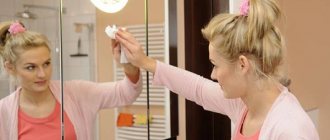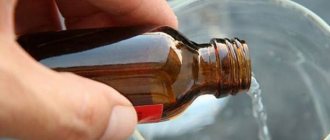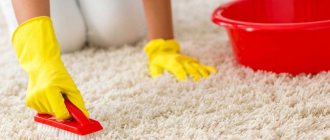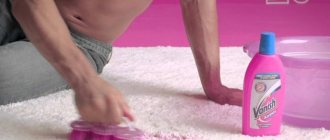Ammonia is an aqueous solution of ammonia. Ammonia // Great Russian Encyclopedia. Electronic version . It is sold in pharmacies, usually in a concentration of 10%. Like baking soda, it can become an indispensable household assistant. Just before use you need to remember a few rules:
- Never mix ammonia (or any product containing ammonia) with bleach. They react and form toxic fumes. If you are going to combine ammonia with a ready-made cleaning product, be sure to check that the composition does not contain chlorine.
- Ammonia causes irritation to mucous membranes and skin. When working with it, wear rubber gloves and ventilate the room well.
- If ammonia gets into your eyes, rinse them with plenty of cold water. If you notice problems with your vision after this, consult your doctor immediately.
Treat stains on clothes
Mix 150 ml of ammonia, 150 ml of dishwashing detergent, 6 tablespoons of soda and 2 cups of warm water. Apply the mixture to the stain and leave for half an hour, and then wash the item as usual. For stubborn stains, such as blood or grass, you can use a mixture of alcohol and water in a 1:1 ratio.
This method will help deal with stains on cotton and polyester fabric. But you can’t use ammonia on wool and silk, these fabrics are too delicate.
Window cleaning
Ammonia is great for cleaning windows. He will make sure that they shine clean for a long time, and will protect their surface from dust and dirt for as long as possible. The main thing is to correctly calculate the dosage. Indeed, despite the fact that the product quickly dissolves acids and easily copes with any contaminants, it has a characteristic pungent and unpleasant odor.
In order to make the correct solution, you need to mix one tablespoon of ammonia with 1 liter of water. You can start washing. It is most convenient to use a spray bottle. Then rub the washed surface with soft paper or newspaper.
Causes of darkening of silver
Under what conditions and why does silver turn black? The essence of the process is that argentum actively reacts with sulfur. And in the air, in addition to oxygen, there is a small amount of hydrogen sulfide. Therefore, over time, the products turn black, combining with hydrogen sulfide and forming a film called silver sulfide.
Silver ring "Snake" turned black
The following factors provoke blackening of silver:
- Low quality product. Most likely, copper was added as an alloy, and it accelerates the process of oxidation and blackening.
- Constantly worn on the body. Dust, dirt, skin particles, and sweat stick to the jewelry, which can affect the color change of the product.
- High air humidity or constant exposure of jewelry to water.
- Contact with cosmetics or medications that contain small amounts of sulfur.
But not all products form this layer. The fact is that recently a lot of jewelry has been produced that is coated with a layer of rhodium. This metal prevents sulfur and silver from coming into contact, protecting the product from blackening.
Or there are also oxidized or blackened silver jewelry. Such a dark shade is natural for them, so you don’t need to clean them so carefully so as not to remove the top layer.
Well, in ordinary products you can simply get rid of this film by cleaning your home decoration. If jewelry cleaning products are available in jewelry workshops, it is better to take them there. They are guaranteed to clean the product without scratching or causing harm. This is done using special gels that do not damage the surface of the jewelry.
Cleaning the soleplate of the iron
If there are burnt marks, plaque or grease left on the sole of the iron, you can get rid of them using a mixture of 1 part ammonia and 1 part vinegar. To do this, you need to moisten a soft cloth in the solution and simply wipe the iron. Not only will dirty stains disappear, but a “store-bought” shine will also appear.
The main thing is to dry the ceramic coating with a towel or napkin after washing. It is better to carry out the procedure with rubber gloves and with the window open.
General information about ammonia
Ammonia (ammonia) has been used for a very long time. It looks like ordinary water, but has a specific and pungent odor. This substance is very poisonous in large quantities, but in small doses it has a stimulating and irritating effect.
It is necessary to distinguish between ammonia (ammonium chloride) and ammonia (ammonia). Use in everyday life and in the medical field is associated precisely with the last resort. At the same time, ammonia is not used in everyday life.
In medicine it is used in the following cases:
During inhalation, ammonia affects the respiratory receptors, activating the respiratory center. The excitation is then sent to the nerve fibers, affecting the functioning of the cardiovascular system. Therefore, ammonia is often used for alcohol poisoning and fainting. However, it must be used very carefully, since regular inhalation of concentrated ammonia can cause pulmonary spasms and lead to respiratory arrest.- If you drink products based on the substance in question, you can provoke vomiting.
- Ammonia also allows you to suppress areas of muscle excitation and eliminate pain.
- In addition, the substance is characterized by an antiseptic effect. That is, it can be used for boils and insect bites.
- In some cases, ammonia is used in combination with other substances to expectorate phlegm. By acting on the epithelium of the respiratory system, it activates the glands, promoting abundant sputum production.
Interesting Facts
- Before surgery, surgeons use ammonia as an antiseptic for disinfection, treating their hands with the substance.
- The human body is capable of producing ammonia itself, removing it through urination.
- Many garden and indoor plants can be fed with ammonia-based products.
- Previously, powdered ammonia was used as a diuretic, but the danger of the drug and the active development of medical technologies made it possible to replace this drug with safer means.
How to get rid of unpleasant odor in the house
You should start eliminating the smell of cigarettes from your apartment by cleaning the fabric coverings:
- tulles and curtains;
- pillows and blankets;
- carpets.
Fabrics absorb smoke more than anything else. Therefore, in order to completely remove the smell of tobacco in the apartment, you need to get rid of the most smoky things.
Fact! It is not enough to wash pillowcases and duvet covers; pillows and blankets should be taken to the dry cleaner.
Carpet cleaning at home
How to clean a carpet at home
Carpets are an integral part of the interior. To keep them presentable, they need regular and proper care. It is important for owners of these products to stock up on information on how to clean a carpet at home.
Fleecy coatings continuously generate static electricity, which continuously attracts various household waste, shoe prints, pet fur and unpleasant odors. Not only professional cleaning products, but also carpet cleaning methods available at home will help you take care of the cleanliness and freshness of your carpets. Such life hacks will be useful for every housewife who strives to maintain not only the external cleanliness of her home, but also wants to be confident in the absolute cleanliness and safety of the products in her home. Sometimes mixing a couple of simple ingredients that can be found in any kitchen produces great results.
Cleaning carpets at home using folk remedies
The following tools are available in almost every home, they are affordable and have a high level of productivity in capable hands:
- Laundry soap.
The most common soap is an excellent alternative to expensive professional products due to the following qualities:
- It does not harm the appearance of the carpet even with regular use.
Effectively removes dirt, including oil stains and grease.
- It has pronounced bacteriostatic properties.
- Vinegar.
Regular table vinegar is great for cleaning carpets at home. It can especially effectively and instantly eliminate pungent odors and help restore color brightness. The recipe is simple: a tablespoon per liter of water, room or slightly warm water. Before cleaning, the coating must be thoroughly vacuumed, then take a stiff brush and clean it with a special solution. The product is rubbed into the carpet and cleaned with a medium-hard brush. After half an hour, the coating should be dried and vacuumed.
- Soda.
Such an affordable product is not only effective, but also delicate. It allows you to quickly clean the carpet at home, ridding it of old stains. Half a glass of soda should be dissolved in a five-liter container with warm water, then arm yourself with a stiff brush and begin wet cleaning the carpet.
- Hydrogen peroxide.
A cheap product that has proven itself in eliminating blood stains and unpleasant odors. To prepare the stain remover, you will need a glass of warm water, 100 ml of peroxide, and half a tablespoon of baking soda. The components are mixed until completely dissolved, poured into a spray bottle and stored in a cool place. For old stains, peroxide is used in combination with vinegar and juice squeezed from lemon.
- Ammonia.
The main advantage for cleaning carpets at home, which is especially important when cleaning the floor. With it you can:
- clean the carpet from paints and greasy stains;
remove fresh stains from coloring drinks;
- restore the carpet to its original color brightness.
- Detergents (standard household chemicals).
An impressive range of quite effective products is available in stores. They can be used to clean an old carpet, restoring its color and fiber structure. Available on the market:
- Moistened powders - used to care for large surfaces. There is no need to dilute them with water: just apply them in an even layer and let them dry for half an hour. Next, the remaining product is collected using a vacuum cleaner.
Stain remover sprays – suitable for dealing with small stains. Such products are convenient against “local” stains when the carpet does not need full cleaning.
- Shampoos for hairy products are indispensable helpers in every home. Before use, they will dissolve in warm water in a ratio of 1:9. If the coating is heavily soiled, it should be moistened with undiluted shampoo before treatment. Families with small children should use antibacterial shampoos - for example, Vanish with disinfectant properties.
- Concentrates for washing vacuum cleaners. These products are also diluted with water at the rate of one and a half caps per liter of warm water. The cleaned carpet must be completely dry, after which it must be cleaned again, but without shampoo.
- Active foam is a product that effectively removes stubborn dirt. Available in convenient cans of various sizes. To achieve the best result, the foam is sprayed at a distance of 70-90 cm from the coating. The remaining product is collected with a vacuum cleaner after complete drying.
- Kerosene and gasoline.
Found a kerosene stain on your wool carpet? Don't bother with detergents - better look for gasoline. Wipe the stain until the gasoline evaporates or place blotting paper under the cloth.
- Citric acid and lemon juice.
To remove stains from nylon, polyurethane foam or polyester, use citric acid in combination with vinegar in a ratio of 1 tablespoon per liter of warm water. Spread the resulting mixture evenly over the carpet using a spray bottle and remove the residue after 30-40 minutes.
- Snow
- An effective home remedy for cleaning carpets. It is important that it is absolutely clean, dry and crumbly. Treating a carpet with snow looks quite simple: the covering is spread with the pile down, turned over, after which the snow is swept over it with a broom. As soon as it has absorbed all the dust and dirt, the snow needs to be swept away with a broom. After the first application, the effect may not be very noticeable, which will indicate the need for repeated cleaning. Snow not only removes dust, but also gives the carpet a pleasant frosty freshness.
Before you clean your carpet, you need to prepare your soap properly. For the best effect, it should be turned into shavings and then diluted in water. The proportions are not so important; it is enough to use a tablespoon per liter of warm water. As soon as the shavings are completely dissolved, a tablespoon of turpentine is added to the resulting solution. The composition is applied to the entire surface of the carpet using a stiff synthetic brush. Then the coating should be thoroughly wiped with a damp cloth, focusing on areas with large stains that have stuck into the surface, the main thing is to maintain the integrity of the pile and the uniformity of the coating.
To clean fleecy coverings, ammonia is mixed with any detergent and diluted in warm water. For a large carpet, a five-liter bucket of water, a few tablespoons of ammonia and a cleaning product are enough. Before cleaning the carpet on the floor, you should ventilate the room well and do not close the windows while cleaning.
Vacuum cleaners
You can clean the carpet at home using a vacuum cleaner. Manufacturers offer a wide range of household assistants. The greatest demand today is for washing vacuum cleaners suitable for productive wet cleaning of fleecy items. It is easy to use: just add a foaming cleaner to a special container. The result of such treatment is impressive - the carpet pleases not only with its cleanliness, but also with a pleasant aroma.
The following shampoos and concentrates are recommended for washing vacuum cleaners:
- Unicum;
- ProTex Thomas;
- Vanish;
- Filtero;
- Help;
- Topper.
Steam cleaners
These devices greatly simplify the care of any type of fleecy coverings. With their help, you can quickly clean the carpet without much effort. Cleaning should be carried out in two stages:
- walk over the carpet with a brush, collecting all the dirt;
- treat the coating with steam, having previously set the mode.
It is important that the coating is not too wet. As soon as the pile dries, you can steam it again.
How to care for long-pile flooring?
Floor coverings with piles up to 10 cm long, also known as shaggies, require special care. In order for the product to remain fluffy and warm, care must be taken to thoroughly clean dust and dirt from the fibers. Before treating the carpet, keep in mind that it gets wet quickly and takes a long time to dry.
Long-haired shags need to be vacuumed at least twice a week. To clean deep stains, it is recommended to clean the carpet without water:
- special foam products;
- cleaners with a gentle composition;
- dry shampoos.
Cleaning floor coverings depending on materials
- Synthetics
Carpets made from synthetic materials are affordable and easy to care for. Also, these products are famous for not accumulating static electricity. To clean such products, it is not necessary to resort to the use of expensive professional products: ordinary Vanish will cope with their work.
Synthetic carpets, being purely decorative products, have low thermal insulation. Here are a few recommendations that require attention before cleaning:
- Nylon carpets quickly fade when exposed to direct sunlight. They should be cleaned and dried in a dark place.
- Coverings made of polypropylene do not need to be hung up and dust knocked out of them.
Deformed polyester products do not recover their shape.
Products made from natural materials are more capricious and demanding compared to synthetic analogues. They are not resistant to moisture and can be damaged by warm and hot water. If the temperature regime is not observed, cleaning the carpet can lead to its shrinkage and deformation, the appearance of bubbles and folds on its surface. To avoid such consequences, natural carpets should not be cleaned with a washing vacuum cleaner - choose regular dry cleaning.
Natural coatings should be treated with a soft sponge and special foaming agents. Cotton carpets deserve special attention, as they:
- prone to sunburn;
sensitive to chemical reagents;
It is better to refuse a vacuum cleaner in the case of silk coatings. Hand cleaning using a soft sponge is recommended. Before processing, the product should be shaken out without resorting to knocking out dust. For coatings with a combined pile (for example, viscose-wool), use of a vacuum cleaner is allowed only at low suction mode, since the turbo brush can damage delicate fibers.
A regular broom, a moderately stiff brush or a vacuum cleaner at low power will help you quickly clean a viscose carpet at home. An excessively hard brush can damage the structure of the fibers, and high power of the vacuum cleaner can cause strong lint release. For old stains, viscose carpets should be dry cleaned.
Cleaning light, dark and colored surfaces
It’s hard to argue with the fact that light-colored carpets look impressive and strong, and also visually expand the space. And yet they are very easily soiled: the product literally attracts dust and dirt. Such coatings should be vacuumed strictly in the direction of the pile to avoid the appearance of cleaning marks.
Local carpet cleaning is also not the best solution. Attempts to remove stains in this way can lead to the formation of a “halo”, which is not easy to get rid of. To prevent this from happening, you should use water with caution, preferably replacing it with active foam or a professional spray. To prepare it you will need:
- a small amount of hydrogen peroxide dissolved in 300 ml of water;
- spray;
- baking soda.
Before spraying the carpet onto the carpet, apply a layer of baking soda to the carpet. The product should be left to dry for 15 minutes, after which the remaining cleaning agent should be removed. This method allows you to restore the color of the carpet, eliminate the gray tint, and also remove unpleasant odors.
Important:
light-colored carpets are afraid of lemon. Citrus juice turns the pile yellowish.
Specific spots
Fat
Grease stains from food, traces of hand cream and various sauces can be removed using dishwashing detergents. Apply a small amount of product to a damp cloth or sponge, after which you only need to wipe the contaminated areas. As soon as there is no trace left of the stain, you need to thoroughly rinse off the remaining product and dry the carpet.
Coloring drinks and liquids
Accidentally spilled wine, fruit or berry juice on your favorite carpet? The main thing is to proceed without delay, blotting the wet spot with a paper napkin or towel. You can pour a little white wine onto a red wine stain to neutralize the color, then rinse the item with water and dry it. An equally effective method is to generously sprinkle the stain with salt and leave it for 10-15 minutes, then vacuum it up. Traces of tea, coffee and juices can be washed with ordinary soapy water.
Oil stains
If the carpet is made of synthetic materials, wool, cotton or linen, cover the stained area with a cloth soaked in hot water. This way the stain will become saturated with moisture and become wet, making it easy to clean.
Viscose carpets, as well as handmade products, are susceptible to wet cleaning. You can take the risk of cleaning the carpet at home, but it is better to take it to a dry cleaner.
Fresh oil stains should be blotted with paper napkins or a towel. In this case, movements should be made in the direction up and down or from the edge to the center. This method is effective against stains from sunflower, olive, and machine oil.
Plasticine and chewing gum
Let's consider an affordable, yet effective way to remove traces of plasticine or chewing gum from a carpet:
- Take a white paper napkin folded in half and place it on the stain;
- heat the napkin in the area of contamination using an iron until a trace of chewing gum or plasticine appears on it;
- remove the napkin, wipe off any remaining dirt with a sponge soaked in soapy water.
heat the iron to maximum temperature without using steam;
Blood
A faithful assistant in removing blood stains is cold water. Fill a basin with clean water and generously dampen a white rag with it, then begin washing the stain until it completely disappears. Afterwards, dry the carpet with napkins or towels and thoroughly wipe the floor under the carpet.
If the bloody stains are old, you need to soak them with ice cubes before removing them. Place them directly on the stain to defrost, then remove the soaked stain.
Zelenka
A fresh stain from brilliant green can be removed by treating it with a solution of water and any detergent. The dirt should not be rubbed too intensely so that the stain does not increase in size. To do this, use a soft sponge or rag. To ensure that no trace of brilliant green remains, replace regular water with carbonated mineral water. Air bubbles improve the processes of separating the components of the brilliant green from the fibers.
Stubborn stains from brilliant green can be removed with 10% ammonia. A small amount is applied to the coating using a cotton pad or cloth.
What is the best way to clean wool from carpet?
To clean the carpet from fur from furry pets, use a brush with medium-hard bristles dipped in water. You need to clean the coating in the direction of the pile, occasionally using circular movements. From time to time, the brush needs to be moistened in water, collecting pellets of wool from it. This method cannot be called quick and simple, but it is quite effective in cases where it is necessary to collect wool of short and medium length.
Special rollers with adhesive tape are also available for sale, convenient for cleaning carpets. By rolling the roller in different directions, you can collect lint not only from floor coverings, but also from pillows and clothes. During the cleaning process, the adhesive tape must be peeled off, as it quickly collects dust, lint and lint.
Carpets made from delicate materials can be cleaned with a velor brush for the care of woolen coats and suits. The brush must be moved strictly in the direction of the pile. The process takes a lot of time and requires scrupulousness, which pays off with excellent results.
How to get rid of an unpleasant smell from a carpet?
This issue is especially relevant for pet owners. Even if the pet relieved itself on the carpet only once, the unpleasant smell will bother the household every now and then. Old stains create comfortable conditions for the proliferation of pathogenic microbes, so you should get rid of them as soon as possible.
It’s easy to clean carpet from unpleasant odors at home:
- First you need to free the product from the source of the odor.
- Next, an vinegar-water solution prepared at a ratio of 1:3 is applied to the contaminated area.
- After several hours, sprinkle the stain with an absorbent (baking soda will do).
- Then the contaminated area is treated with a soap solution with the addition of a small amount (up to 70-100 ml) of hydrogen peroxide.
- After drying, the mixture is removed with a vacuum cleaner or brush.
- To give the product freshness, you can spray fabric softener on it.
Glycerin helps eliminate urine odor. Its use promotes the dissolution of uric acid, which is resistant to alcohol. Alternatively you can also use:
- potassium permanganate;
- lemon juice (not for light-colored carpets);
- laundry or glycerin soap.
For safety reasons, oxidizing agents are pre-tested on inconspicuous areas of the product.
***
Simple but proven tips will help you properly clean your carpet at home. The above recipes and methods allow you to save on professional dry cleaning services and find use for standard home products for productive cleaning.
Carpet cleaning with modern means
Steam generator (steam cleaner)
A steam generator (steam cleaner) allows you to not only clean the carpet of old dirt, but also kill the microscopic mites living in them, as well as disinfect the carpet.
- The first step is to free the carpet from the furniture.
- Vacuum the carpet thoroughly to remove small debris.
- Make a solution for cleaning carpets by adding special products to it or clean the carpet with plain water.
- Treat the carpet with a steam cleaner.
- Wait for the carpet to dry.
Steam cleaning is a good modern method of cleaning and disinfecting carpets
Modern chemicals
You can clean the carpet using modern chemical compounds, the main brands of which are:
- Vanish,
- Biryusa,
- Prosept,
- Nordland,
- Tri-Bi,
- Karcher,
- and others.
To clean your carpet, simply follow the instructions on the package.
There are specialized products on sale specifically designed for cleaning carpets.
Fabric bleach
Over time, during wear, any white item loses its original color and begins to fade, acquiring a gray tint. Washing machines with the best powders and bleaches may no longer cope with this problem. Quite often such things end up in rags.
However, “grandmother’s” recipes using ammonia will help here too. It is enough to combine one tablespoon with two tablespoons of 3% hydrogen peroxide and pour everything into a bucket of hot (60-70°C) water. First you need to wash the laundry, then pour the prepared solution into it so that it covers the clothes for 20 minutes. Then rinse twice in running water.
Cleaning suede items
You can clean suede items from dirt, salt and grease stains using ammonia and water. This will be a delicate and high-quality cleaning that does not leave plaque, stains or streaks on the surface.
To do this, you need to mix 1 part ammonia and 4 parts water. Wipe with a cotton pad moistened with the prepared product. It is necessary to change the disk when it becomes dirty. Finish cleaning with a cotton pad moistened with water and vinegar (1 teaspoon per 1 liter of water). After this, be sure to let the fabric dry completely.
The smell is the same, but the substances are different
In order to be convinced once and for all that ammonia and ammonia are the same thing, it is enough to turn to the history of their origin and look at their chemical formulas.
Ammonia is a hydrogen nitride, a gas with a molar mass of 17 g/mol, the chemical formula is NH3.
Ammonia or ammonia alcohol is a liquid with the chemical formula NH4OH.
Ammonia is a salt with the chemical formula - NH4Cl.
Origin of ammonia
The history of the discovery of natural ammonia gas has two legends. According to the first legend, near the temple of the Egyptian god Amon, where religious rites were performed, people sniffed a pair of camel excrement, which caused them to fall into a trance. These vapors were called "ammonia".
According to the second legend, in northern Africa, in the area of the Ammon oasis, there was an intersection of caravan routes. A huge number of animals passed there, the road was strewn with their feces and abundantly watered with urine, which evaporated and released a gas called “ammonia”.
As for the scientific discovery of a gas called “ammonia,” it dates back to 1785. The chemical formula of the gas, NH3, was determined by the French scientist C. L. Berthollet and named it “ammonia.”
But back in 1774, the English scientist D. Priestley obtained an identical gas, which he gave the name “alkaline air,” but could not determine the chemical composition.
Ammonia (ammonia in Latin) is a colorless gas with a specific odor, lighter than air, chemically active, liquefied at a temperature of -33 C; dissolves well in water, has an alkaline reaction; interacts with hydrochloric acid and forms an ammonium salt: NH3 + HCl = NH4Cl, which decomposes when heated: NH4Cl = NH3 + HCl.
Ammonia is produced in two ways - industrial and laboratory. In the laboratory method, ammonia is obtained by heating alkalis and ammonium salts:
- NH4Cl + KOH = NH3 ↑ + KCl + H2O;
- NH4 + + OH - = NH 3 ↑ + H2O.
In industrial settings, ammonia is first produced in gaseous form and then liquefied into a 25% aqueous solution called ammonia water.
Ammonia synthesis is a very important chemical production, since ammonia is a fundamental element for many other chemical technologies and industries. Thus, ammonia is used in industrial refrigeration units as a refrigerant; is a bleaching agent for processing and dyeing fabrics; indispensable in the production of nitric acid, nitrogen fertilizers, ammonium salts, synthetic fibers - nylon and nylon.











